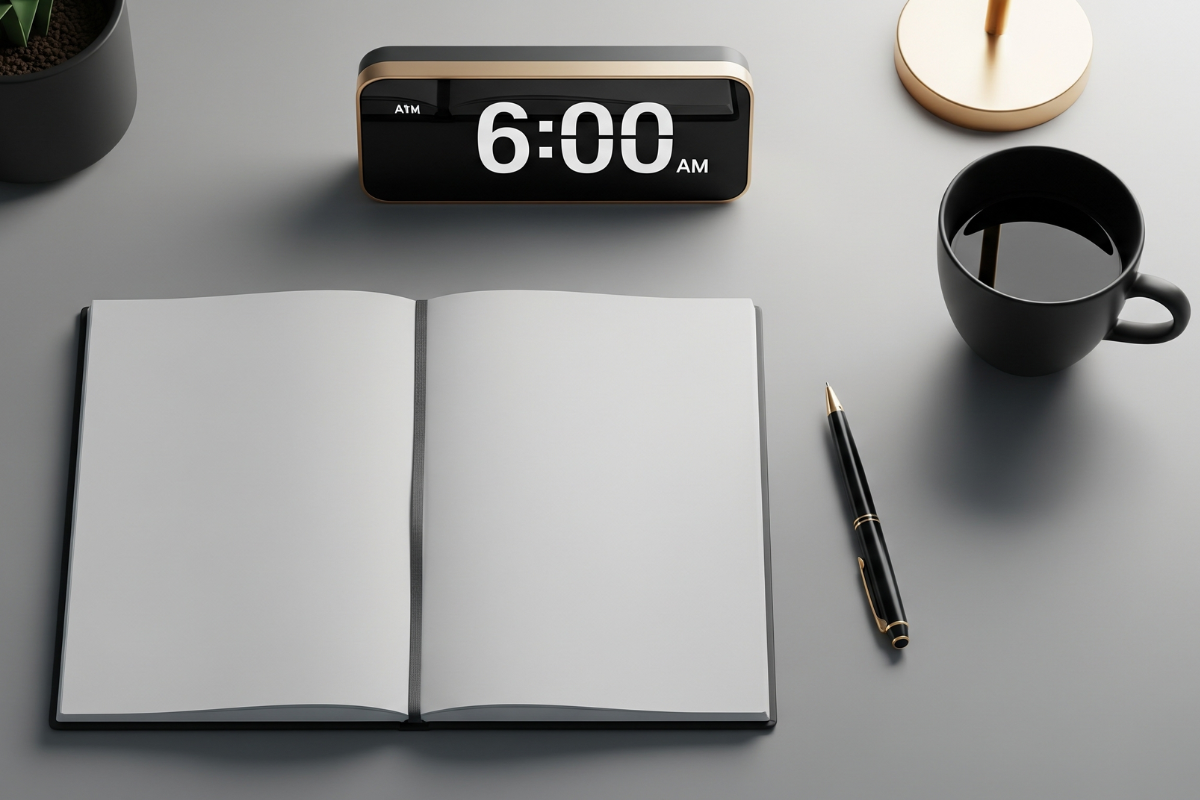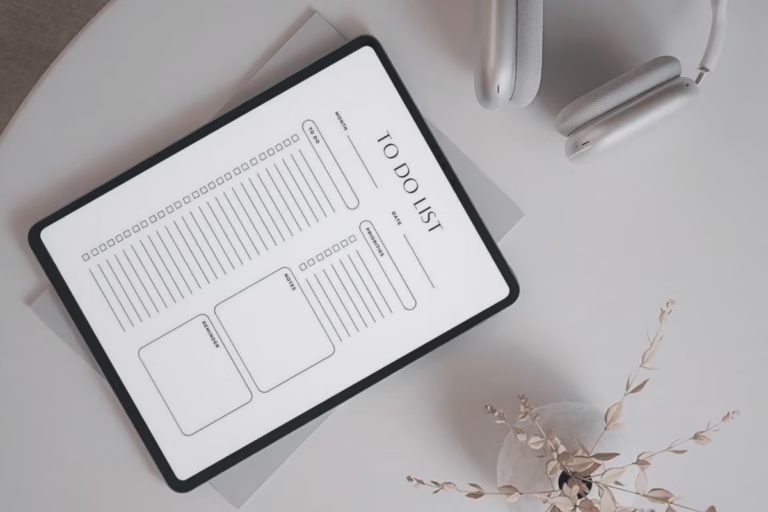How to Build a High Performance Daily Routine That Lasts
A high performance daily routine isn’t simply about doing more—it’s about leveraging intentional structure to consistently achieve your most important goals. Unlike ordinary routines, which may rely on motivation or vague productivity tips, a high-performance system is meticulously designed around effective time management, precise energy allocation, and strategic focus.
If you’re ambitious, you already understand that hard work alone isn’t enough; without a clear framework, valuable hours vanish into friction, decision fatigue, and context-switching.
In this guide, you’ll discover exactly how to build a daily routine that aligns seamlessly with your identity, enhances productivity, and sustains elite output—day after day.
Let’s begin at the foundation.


What Is a High-Performance Daily Routine?
A high-performance daily routine is a system—custom-built to match your goals, energy patterns, and mental capacity. It’s structured, yet adaptive. Disciplined, but not restrictive. And most importantly, it’s designed to sustain results over the long term without burning you out.
It’s not just about waking up early or checking off tasks. It’s about aligning your time, attention, and actions with what matters most—and doing it with rhythm, clarity, and control.
The Difference Between Productive and High-Performance
Productivity is about output. Performance is about intentional output.
A productive schedule might get a lot done, but a high performance daily routine ensures you’re doing the right things at the right times with the least resistance. It doesn’t just track your actions—it upgrades them.
Where productivity asks: “How can I fit more into my day?”
High performance asks: “What would make this day unmissable?”
The difference isn’t just in what gets done. It’s in how it gets done—strategically, without waste, and with standards that rise over time.
You don’t need more hours. You need a performance system that extracts more value from the ones you already have.
The Psychology of a High-Performance Daily Routine
Beneath every great routine is psychology. Repetition isn’t just habit-building—it’s identity formation.
Your brain craves patterns. Every time you execute a behavior, you strengthen a neural pathway. This is called neuroplasticity, and it’s the foundation of routine design. The more consistently you work in alignment with your goals, the more natural high performance becomes.
But routines also reduce decision fatigue—the slow erosion of willpower from constant choice. When your day is designed with intention, you conserve mental energy. Clarity replaces chaos.
This mental stillness unlocks what high performers rely on most: focus. With a calm, clear mind, you can enter flow states, execute deep work, and operate with precision.
In short: the more refined your routine, the fewer decisions you make—and the more space you create for performance.


Why High-Performers Follow a System
Discipline fades when it depends on willpower. That’s why high performers build systems.
Systems don’t just organize your day—they multiply your output, protect your focus, and reduce friction to doing what matters most.
Whether you’re a founder, creator, or athlete, the same law applies: consistency beats intensity. And consistency lives in systems.
Time, Energy, and Focus Are the Real Currency
High performers don’t just manage time—they manage three currencies: time, energy, and focus.
You can time block a task perfectly, but if your energy is drained or your focus scattered, the output suffers. That’s why elite routines don’t treat every hour the same. They’re shaped around:
- Energy management: Scheduling difficult work during high-energy windows
- Deep work blocks: Protecting uninterrupted time for high-leverage tasks
- Focus cycles: Using natural rhythm and recovery to sustain intensity
It’s not just about what you do—it’s when and how you do it. If time is the container, energy is the fuel, and focus is the flame.
A high-performance daily routine maximizes all three.
How Systems Reduce Friction and Decision Fatigue
Every obstacle in your day adds friction. Friction leads to hesitation. Hesitation leads to drift.
But systems remove that friction. They automate your path forward.
Take habit stacking, for example—a method where you attach a new habit to an existing one. This reduces decision fatigue by anchoring your actions to existing neural patterns. One behavior flows into the next, and the routine becomes effortless over time.
Another tool is environmental design—creating a space that makes the right action obvious and the wrong one difficult. When systems do the heavy lifting, you don’t need to negotiate with yourself. The decision is already made.
This is how high performers preserve their cognitive energy for what truly matters. They eliminate noise, reduce options, and move through their day like a clean, controlled current—not in scattered waves.
In short, systems make performance the path of least resistance.


Core Principles of a High-Performance Daily Routine
A high performance daily routine isn’t built on willpower. It’s built on principles—unseen forces that govern how effectively your time, energy, and focus convert into results.
The most consistent high performers structure their day around three core pillars: how they enter deep focus, when they apply their energy, and how they reinforce discipline through structure—not emotion.
Focus First, Then Flow
Performance begins with focus.
Before energy or motivation matter, the mind must be clear and undistracted. That’s why high performers front-load their day with protected blocks for cognitively demanding work. These “deep work” windows—coined by Cal Newport—are periods of full immersion where attention is undivided and output is strategic.
But focus isn’t just an internal state—it’s triggered by rhythm. Many use the Pomodoro Technique or extended “focus cycles” to stay locked in, breaking their day into deep focus sprints followed by intentional recovery.
From these focus blocks emerges something rare: flow state. Flow isn’t a gift—it’s a frequency. And the more consistently your routine aligns to protect deep work, the more often flow becomes your default.
Align Your Tasks With Your Circadian Rhythm
High performers don’t work against their biology—they align with it.
Your circadian rhythm regulates physical energy, cognitive sharpness, and hormone levels throughout the day. Ignoring this rhythm leads to friction. Working with it leads to compound clarity.
The general pattern for most adults:
- Morning (after waking): Ideal for deep focus, problem-solving, and strategic planning
- Afternoon: Best for execution, communication, and lower-demand tasks
- Evening: Suited for reflection, winding down, and resetting
You don’t need to follow a perfect schedule. But aligning key activities—like deep work blocks or creative tasks—with your natural highs will amplify results without extra effort.
Performance isn’t just about what you do. It’s when.
Discipline Comes From Structure, Not Motivation
Motivation is a feeling. Structure is a decision.
To build discipline, you must eliminate the need to choose. A high performance daily routine creates default behaviors—making the right choice automatic and the wrong one inconvenient.
This is where routines shine: they reduce the mental load required to stay consistent. With habit stacking and strategic cues built into your environment, your day flows like a script you’ve already rehearsed.
If you want to build discipline through routine, stop waiting to “feel ready.” Instead, install a system that makes showing up inevitable.


How to Build Your Own High-Performance Daily Routine
There is no perfect routine—only a routine that matches your ambition, energy, and current reality. The goal isn’t to copy someone else’s blueprint. It’s to build your own performance engine.
Here’s how.
Start With Morning Anchors
The high performance morning routine doesn’t start at 5 a.m. It starts with clarity.
The first 90 minutes of your day are sacred. They set the tempo, the tone, and the trajectory of everything that follows. High performers use this window not for checking notifications, but for anchoring their identity and preparing their mind.
Anchors may include:
- Silence or meditation (to clear mental clutter)
- Journaling or shadow work (to surface resistance or intention)
- Movement (to prime physiology)
- Reviewing priorities or goals (to direct focus)
A good morning routine for success isn’t about quantity. It’s about quality of attention. When your first hour is anchored, the rest of your day has a structure to return to.
Use Time Blocking to Own Your Day
Time blocking is the backbone of a high performance daily routine.
Instead of working reactively, you assign every block of time a role—protecting focus, reducing context-switching, and enforcing clarity.
For maximum control, combine time blocking with the Eisenhower Matrix:
- Block your most important, non-urgent tasks first (deep work)
- Batch urgent admin into a dedicated window
- Eliminate or delegate anything that clutters your schedule
This creates a time blocking schedule that isn’t just organized—it’s intentional. Every hour has a purpose. And over time, your day becomes a performance system, not a checklist.
Want to see how time blocking compares to traditional to-do lists—and how to combine them effectively? Explore the full breakdown here.
Design a Personal Performance Window
Not every hour is created equal. That’s why high performers identify and protect their performance window—the 3–5 hour stretch where their mind, energy, and environment are most aligned.
Your performance window may vary. Some peak between 7–11am. Others thrive mid-afternoon. The key is to:
- Track when you do your best work
- Reserve that window for high-leverage tasks
- Guard it from distractions at all costs
This is your prime real estate. Don’t waste it on reactive work, emails, or meetings. Your most important goals deserve your best mental state—not what’s left after everything else.
Use Review and Reflection to Reinforce Progress
High performers don’t just work hard—they zoom out.
A structured daily review system allows you to reinforce wins, extract lessons, and realign priorities. Without this moment of clarity, routines become mindless. With it, performance compounds.
End each day with:
- A win logged
- An insight captured
- One priority identified for tomorrow
This process installs routine consistency without burnout. You’re not just executing tasks—you’re directing a system that gets smarter every day.


Evening Routines and Reset Rituals
Evening routines aren’t just about winding down. They’re about preserving your edge.
Without an intentional close to your day, stress accumulates. Your mind stays active. Your body never signals “we’re done.” A high performance daily routine includes a structured descent—calming the system and clearing the path for recovery.
Wind-Down for Quality Sleep and Recovery
Your evening begins the moment your work ends.
This doesn’t mean logging off at 5 p.m. It means closing loops—mentally, digitally, and emotionally—so your system can power down without residue.
A strong evening wind-down routine might include:
- A fixed “cutoff” time for work
- Journaling or a brain dump to externalize open thoughts
- Light movement or stretching
- Blue-light reduction and low-stimulation inputs (music, reading)
- A sleep ritual that honors stillness
This isn’t optional. Circadian rhythm and recovery cycles are core to sustainable output. No routine can last if the engine isn’t restored.
Even elite focus means nothing without elite recovery.
Rituals That Signal Closure and Reset
High performers don’t drift from one day to the next. They close clean.
Rituals signal the end of effort and the beginning of rest. They tell your brain: “We’ve done enough. You’re safe to let go.”
These rituals don’t need to be spiritual or elaborate. What matters is consistency and intention:
- Cleaning your workspace
- Reviewing your schedule for tomorrow
- Writing down tomorrow’s top priority
- Taking a walk in silence or stillness
- Saying a simple line like, “Day complete.”
These daily ritual examples transform the end of your day from passive to powerful. And by doing so, they preserve the sharpness, clarity, and drive required to show up again tomorrow—stronger, calmer, clearer.


Common Pitfalls (And How to Avoid Them)
A high performance daily routine only works if it’s followed. And the greatest threat to consistency isn’t complexity—it’s subtle, silent friction.
Most people don’t fail because they lack ambition. They fail because they fall into predictable traps that weaken structure and blur intention. These are the most common pitfalls that erode consistency, clarity, and control—and how to avoid them.
Over-Planning Without Execution
Productivity is seductive. It feels good to build spreadsheets, color-code calendars, and design the “perfect” schedule. But the danger here is mistaking preparation for progress.
High performers know the difference between being busy and being effective. A productive daily schedule isn’t about filling space—it’s about protecting priority.
If you find yourself hesitating or over-analyzing instead of acting, there are ways to leverage procrastination intentionally instead of letting it derail you. Learn how to use productive procrastination to create momentum.
Execution reveals more than planning ever will.
Ignoring Energy Levels
Not all hours are created equal—but most routines treat them that way.
One of the fastest ways to sabotage a high performance daily routine is to ignore your own energy management. If your deep work block is scheduled during your lowest-energy hour, you’re not optimizing—you’re grinding.
Instead, reverse the approach: design your day around your energy peaks, not just the clock.
Ask:
- When do I feel mentally sharpest?
- When do I feel foggy or restless?
- When do I hit natural dips in energy?
Align your high-leverage tasks with your high-energy zones. Then reserve lower-focus tasks—like admin, communication, or planning—for your natural valleys. If you’re interested in learning more about managing your energy, Harvard Business Review offers an in-depth article on the topic.
A routine that fights your biology will never last.
Inconsistency and the Myth of Willpower
Willpower is unreliable. And routines that depend on it collapse the moment friction appears.
The most effective performers don’t try to “stay disciplined.” They remove the need for discipline by designing their environment, stacking their habits, and reducing decision points.
For example, use habit stacking to tie new behaviors to actions you already do. Want to begin journaling at night? Stack it onto brushing your teeth. Want to start your deep work session at the same time daily? Pair it with a fixed cue like coffee or movement.
You don’t rise to the level of your intention—you fall to the level of your systems.
Avoiding inconsistency isn’t about being perfect. It’s about designing a structure that makes missing harder than executing.


Sample High-Performance Daily Routine (Template)
Every high performance daily routine is custom-built. But the structure behind each one follows a clear rhythm: control the start, protect the middle, and close with intention.
Below is a performance-based routine template you can adapt. It’s built on energy rhythm, deep work cycles, and identity reinforcement—without sacrificing flexibility.
Morning (7:30am–10:00am)
This is your launch window. What happens here determines the clarity and momentum of your day.
Key Goals:
- Establish identity
- Protect attention
- Prime focus and physiology
Sample Flow:
- Wake at a consistent time (anchor your circadian rhythm)
- 10 minutes of stillness, meditation, or breathwork
- Light movement or cold exposure to activate alertness
- Journaling, prayer, or visual review of goals
- No inputs (notifications, email, social media) until after this sequence
- Begin your morning routine for success with a protected work sprint
Your morning doesn’t need to be long—it needs to be intentional. This is where momentum is built or broken.
Deep Work Block (10:00am–2:00pm)
This is the core of your performance engine. Your highest-leverage tasks should live here, shielded from distraction and interruption.
Key Concepts:
- Schedule 1–2 deep work blocks (60–120 minutes)
- Use the Pomodoro Technique or custom focus cycles
- Eliminate inputs, silence notifications, and pre-decide your priority
Incorporate task prioritization the night before using tools like the Eisenhower Matrix. This ensures you don’t waste energy figuring out what to work on—your system already knows.
This block is where compound progress happens.
Afternoon Sprint + Admin (3:00pm–6:00pm)
Your energy will naturally dip post-lunch. Use this window for tasks that don’t demand peak creativity but still require momentum.
Ideal Activities:
- Meetings or collaborative work
- Admin, documentation, light execution
- Low-friction habit reps (writing drafts, editing, research)
You’re still in motion—just shifting gears.
For many, this becomes the optimal daily routine structure: deep creation in the morning, collaborative or process-driven work in the afternoon, reflection at night.
Evening Review + Reset (8:00pm–10:00pm)
Performance doesn’t end when you stop working—it ends when you reset.
Your evening wind-down routine should:
- Signal closure and safety to the nervous system
- Eliminate digital stimulation at least 60 minutes before sleep
- Include mental stillness: meditation, reading, breathwork
- Include a daily review system:
- 1 win
- 1 insight
- 1 task for tomorrow
This closes your mental loops and clears your emotional cache. It ensures that when you rise, your brain is clean, calm, and ready. Use this time to really reflect on your output for the day. Self awareness is critical when it comes to improving your routine and time management.
Protect your reset. It protects your next day.


Final Thoughts: Performance Is a System, Not a Mood
There’s a reason most routines don’t last. They’re based on moods, not mechanics.
You feel motivated, so you build a routine. Then life gets loud, motivation fades, and the routine dissolves. What remains is chaos—or worse, guilt.
But high performance doesn’t rely on moods. It relies on systems. And systems are indifferent to motivation.
If you want a high-performance daily routine that lasts, make it resilient. Make it modular. And make it match the identity you’re becoming—not the version of you that keeps burning out.
Choose Systems That Scale With You
A high performance daily routine is not a static artifact. It evolves.
What worked during your launch phase might not serve you at scale. What served you at burnout recovery may limit you when your energy returns.
This is why performance optimization techniques matter. You’re not just building a routine—you’re designing infrastructure for the next version of yourself.
Ask weekly:
- Is my system aligned with my current goals?
- What needs to be simplified?
- What is no longer serving my performance?
Your routine should feel like a tailored suit—not an old uniform.
Repetition Builds Identity
The routine you follow is casting votes for the person you’re becoming.
Each repetition strengthens a pattern. Each pattern reinforces identity. And over time, you no longer try to act like a high performer—you are one.
This is the final layer: your routine isn’t about managing your time. It’s about forging your identity.
If you want to become the kind of person who performs at a high level consistently, start by designing a high-performance daily routine that makes that behavior automatic. Then repeat it—until the identity catches up.
This is how high performers operate. Not with chaos. Not with guesswork. But with intention, structure, and systems that win long after motivation disappears.
If you’re interested in a free template to help you minimize distractions while you’re working you download Thovia’s Anti-Distraction Toolkit here.
Useful Tools:
| Tool | Purpose | Best For | Notes |
|---|---|---|---|
| Notion | Workspace + Tracker | Habit stacking, journaling | Highly customizable & clean |
| Sunsama | Daily planning | Time-blocking + energy alignment | Syncs with calendars + tasks |
| Toggl Track | Time tracking | Deep work & performance audits | Easy visual breakdowns |
| Streaks (iOS) | Habit tracker | Keystone habits | Clean, mobile-first design |
Frequently Asked Questions:
u003cbr/u003eu003cstrongu003eHow do you create a high performance daily routine?u003c/strongu003e
u003cbr/u003eTo create a high performance daily routine, start by clarifying your core priorities and peak performance windows. Use u003cstrongu003etime management strategiesu003c/strongu003e like time blocking, align tasks with your natural energy rhythms, and incorporate proven productivity techniques such as u003cstrongu003ehabit stackingu003c/strongu003e and deep work sessions. Regularly review your system to maintain alignment with your goals.
u003cbr/u003eu003cstrongu003eWhat’s the best morning routine for high performance?u003c/strongu003e
u003cbr/u003eThe ideal morning routine for high performance includes activities that anchor clarity, energy, and intention. Effective practices include mindfulness or meditation for focus, journaling for clarity, physical movement to prime your body, and reviewing daily priorities to set clear direction. This structured daily schedule reduces friction and maximizes momentum.
u003cbr/u003eu003cstrongu003eHow can I avoid burnout with a high performance daily routine?u003c/strongu003e
u003cbr/u003eAvoid burnout by designing your routine around your circadian rhythm, incorporating intentional recovery periods, and establishing clear boundaries between work and rest. Use u003cstrongu003eevening reset ritualsu003c/strongu003e like journaling, meditation, or light stretching to signal closure. Prioritize elite recovery as much as elite performance.
u003cbr/u003eu003cstrongu003eWhy is time management critical to sustaining a daily routine?u003c/strongu003e
u003cbr/u003eEffective time management prevents your routine from becoming chaotic or overwhelming. It ensures you allocate energy and attention strategically, reducing context-switching, friction, and decision fatigue. By managing time intentionally, you sustain consistent, structured productivity that aligns with your long-term goals.
u003cbr/u003eu003cstrongu003eWhat common mistakes derail a daily routine for productivity?u003c/strongu003e
u003cbr/u003eThe most common pitfalls include overplanning without execution, ignoring your natural energy patterns, and depending solely on motivation or willpower. Avoid these by focusing on actionable simplicity, scheduling tasks around your personal performance windows, and relying on structured systems instead of emotions to maintain discipline.





